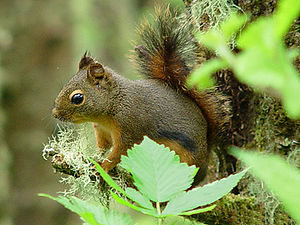
Freshman zoology major Anneliese Detmer connected with one of the squirrels on campus through its stomach. It all started when she noticed one of the squirrels that frequents Braiden Hall annoying another girl.
“One day he was harassing this girl for food and she was freaking out about the squirrel being near her, so I drew him away — with a mint — from the girl,” Detmer said.
Detmer feeds the squirrel — that she has now named Dr. Bushytail — three to four times a week.
“I named him that because we live on a campus and my friend and I thought it was appropriate that he had a doctorate and it was also ironic ’cause part of his tail is missing,” Detmer said. “That’s how I identify him too — by his half tail. He really likes mints for some reason and just a couple days ago I was feeding him and he allowed me to pet him while he munched on a cracker. Pretty much the best thing ever.”
Other students, like senior horticulture major Kevin Hicks, play with the squirrels for entertainment.
In the fall when the squirrels are burying their nuts, Hicks will dig out their nut while the squirrel is watching, and throw it back to them.
“The squirrels will usually look confused as hell and then usually re-bury the acorn,” Hicks said.
The point of his game is to see how many times the squirrel will continue to bury the acorn after Hicks digs them up. However, Hicks’ game requires a lot of skill. In order to get to squirrel to continue to bury the nut, Hicks must toss it to where the squirrel is looking.
“It’s like fishing, you can’t throw it at him, but it has to still be close enough to see it,” Hicks said. “It seems simple, but there are little details to doing it right.”
For Hicks, one of those details is body language. According to Hicks, the key is to not come off aggressive, like a predator.
“You don’t want to be squared off, and you don’t want to be facing them dead on,” said Hicks. “Be easy. I think that if you have a blade of grass or something in your mouth (while playing), then they see you as a herbivore instead of a predator. Downplay the predator.”
“I didn’t know what to do it the acorn; I wasn’t going to eat it,” Hicks said. “So, I just gave it back and it started a new fun activity.”
So far, Hicks’ record for how many times he can get a squirrel to rebury the acorn is five times.
“He got so mad that he climbed to a tree branch at eye level and just stared and barked at me,” Hicks said.
Besides entertaining students, the squirrels on campus are important to the Wildlife Data Collection and Analysis class for their studies.
The class deals with data collection and anaylsis, and in order to get experience handling wildlife, they practice trapping, handling and putting radio collars on the squirrels for the semester.
According to Paul Doherty, Jr., one of the professors who taught the class in previous years, the students can look at habitat use of the campus, territory size and location on campus at different times in the day or semester.
The class ensures that the squirrels are treated humanely. They use a hard trap called “Have a Heart,” which is a walk-in box trap they bait with peanut butter or apples, and they also have to have animal care permits to handle the squirrels.
“(We use the squirrels because) of availability,” Doherty said. “There are lots on campus and they are easy to catch. We could do foxes or rabbits, but there aren’t as many, and birds are too hard to catch. Squirrels are convenient, visible, and people really like them.”
“I think the students enjoy it,” added Doherty. “They really learn a lot from the squirrels.”
Collegian Writer Taylor Pettaway can be reached at news@collegian.com





